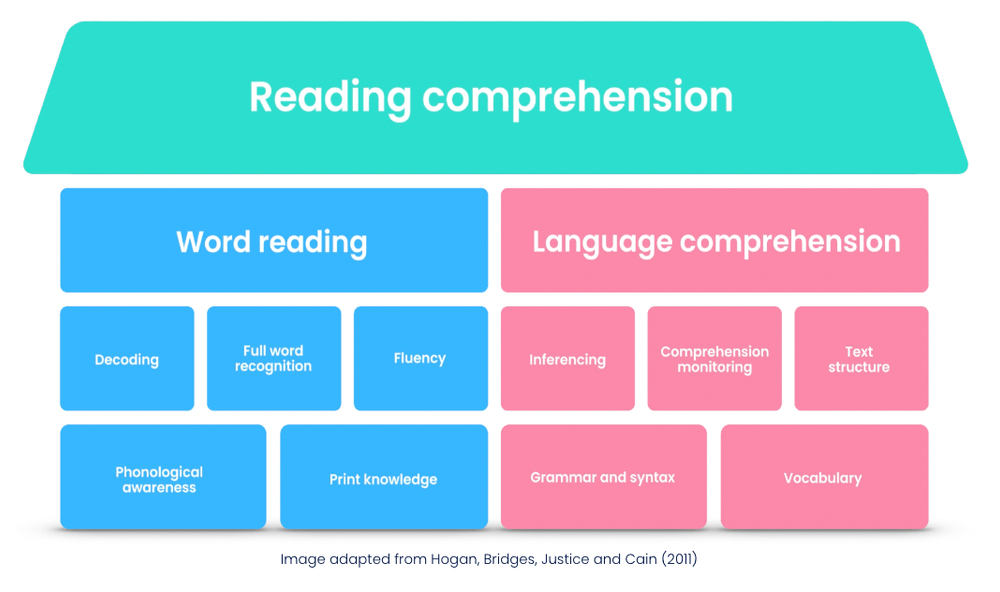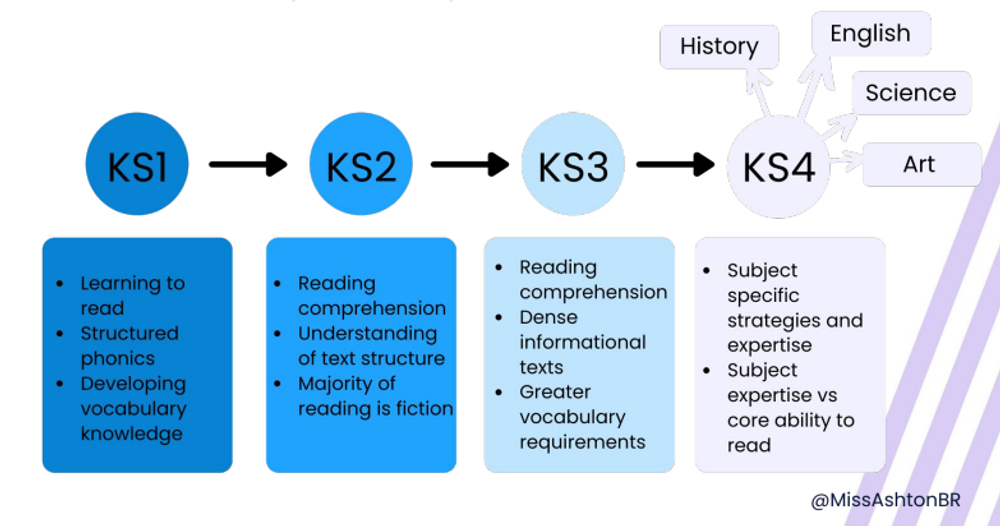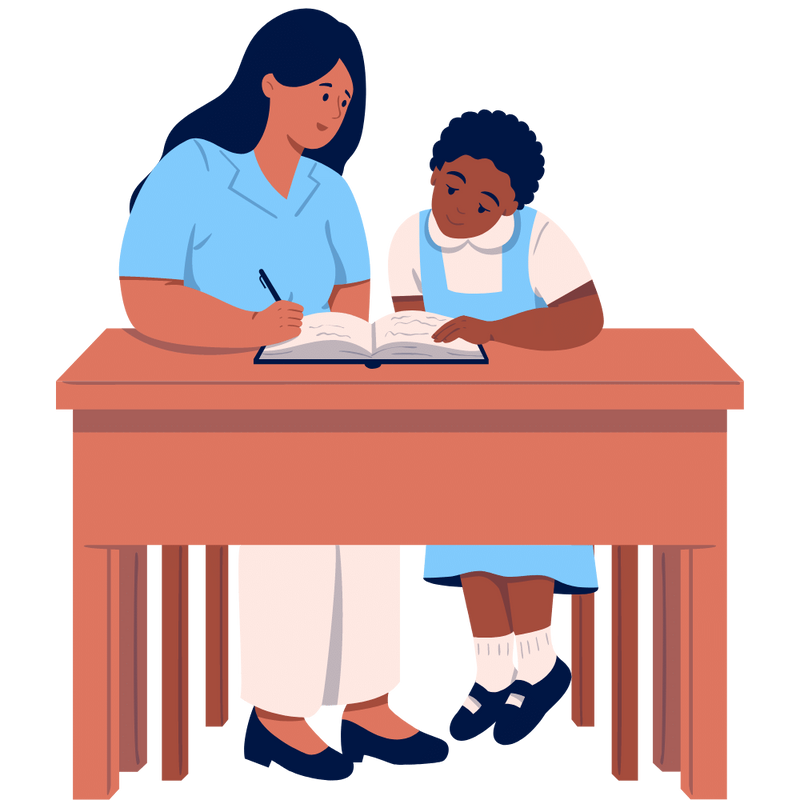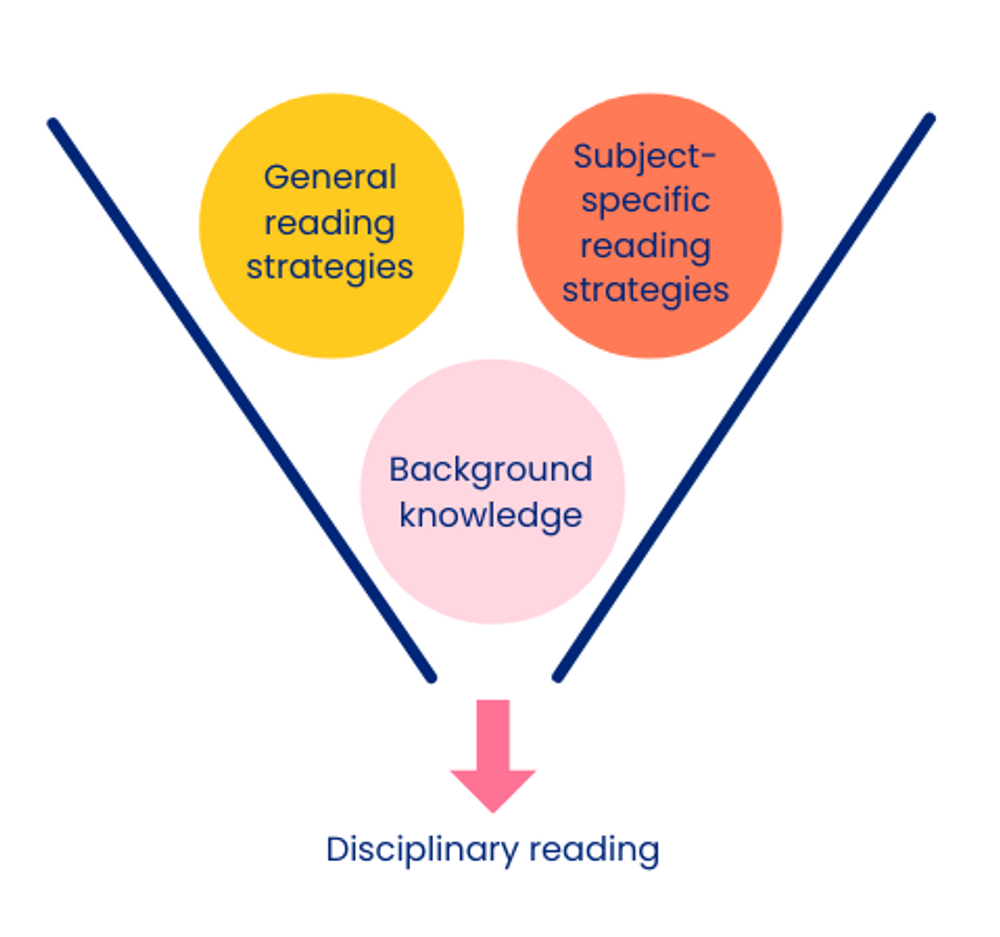Reading complex academic texts
Reading is complex. When the text is complex, reading is even more complex. How on earth do you support learners in overcoming this challenge?!
In my webinar, I deep-dive into how educators can develop learners’ ability to read complex academic texts, compiling strategies and research around the following questions:
- What does it mean to read complex academic texts?
- How are we addressing reading complex academic texts?
- So what practical steps can you take to develop learners’ ability to read complex academic texts and your whole-school journey?
The Reading House

This is my all-time favourite graphic for summarising the complexities of reading. This Reading House is adapted from Gough and Tunmer (1986)’s Simple View of Reading - in order to read, you must learn word reading and language comprehension.
The Reading House is excellent because it combines all the necessary parts of reading into key building blocks. Not only does it show us the blocks a learner must know to progress to the next stage of learning, it can also help us to highlight areas a learner might be struggling with, and also build a literacy strategy.
Just like with an actual house, if there are weak foundations, the entire house is vulnerable. This metaphor identifies that if a learner has a weakness, such as vocabulary, it will have a detrimental impact on a learner’s academic success.
What makes a text ‘complex’?
Alex Quigley has identified eight features of a difficult text, known as the “Arduous Eight”:
- Necessary background knowledge
- Range and complexity of vocabulary, including word length
- Abstract imagery and metaphorical language
- Sentence length and syntax
- Narrative and whole-text structures
- The generic elements in a text, eg. a biographical account in History
- Scaffolds present, or absent, in a text, eg. a keyword glossary
- Text length
Identifying the areas of complexity within your text choices enables you to further support your learners in the classroom.
Other ways of determining a text’s readability is using the Flesch Kincaid scale and other ranking systems which I introduced in a previous webinar. These are great ways of establishing the reading age and difficulty of a text.
How do students’ reading skills improve throughout their academic lives?
A learners’ reading skills build and progressively become more challenging throughout the key stages. In Key Stages 1 and 2, teachers have a deep knowledge of the building blocks of reading. However, the consideration of what has come before is often forgotten within the secondary school CPD calendar due to the focus on subject content.

What happens if a learner joins KS3 without meeting the expected standard in KS2 reading, a situation many will find themselves in due to Covid-19 learning gaps?
Before a learner in KS3 can embark on comprehending dense informational texts and building a larger repertoire of Tier 2 and Tier 3 vocabulary, areas of weakness within the Reading House must be addressed.
A strong understanding, and support from our primary colleagues’ expertise, will enable the weak building blocks to be identified and the house rebuilt.
8 strategies for improving students’ reading
Improving learners’ reading requires a multifaceted approach. There are many areas that can be focused on - here are just a small handful:
- Reading academic texts
- Paired/group reading
- Disciplinary reading
- Independent and whole-class reading
- Developing strategic readers
- Promoting reading for pleasure
- Supporting struggling readers
- Writing to support reading
In this webinar, I mainly focused on sharing strategies for disciplinary reading and reading academic texts, touching upon group reading strategies briefly as well.
"Reading offers us a vehicle to store and share essential information and knowledge of our culture." - Alex Quigley
Why is academic reading important?
Academic reading provides a means of teaching subject content while introducing and reinforcing ambitious vocabulary, modelling reading comprehension and improving writing skills.
Reading comprehension is more than just part of the National Curriculum for KS1-4: it’s a skill for life. Reading comprehension requires learners to make inferences and think critically about texts - things a mature reader might do without thinking, but that need explicit teaching for struggling readers.
As well as this, academic reading is crucial for subjects outside of English. AQA’s text on disciplinary language in GCSE Science states: “Opportunities to read, write and talk about science are an essential part of improving the precision of writing needed in exam questions.” Teaching academic reading in every subject models the communication skills learners need for their exams, and for the wider world.
How can you support struggling readers when teaching complex texts?
Instead of making our texts easier, we have to teach to the top and scaffold all learners to get there. It’s important not to present your learners with easy texts to read - and I’m guilty of this! - just because you think they may struggle to read complex texts. Instead, complex texts allow us to see where learners are struggling and identify the blocks of the house that they need support with.
Complex academic texts are different in every subject. These differences require different approaches. A complex academic text in a Maths paper and a complex academic text in Music look nothing alike. We explore this idea further in the full webinar.

How does reading complex texts differ from subject to subject?

In my previous webinar, we talked about disciplinary literacy and the needs in each subject. Reading forms a vital strand of improving disciplinary literacy. My first recommendation would be to audit where your departments are currently with disciplinary reading.
So what is disciplinary reading? Well, it is the combination of general reading skills, subject-specific strategies and background knowledge.
How are texts selected?
"Some books are to be tasted, others to be swallowed and some few to be chewed and digested." - Francis Bacon
To echo Francis Bacon, it is important to consider the purpose of the text that is going to be read, this will influence the approach taken. Is it a text for in-depth study? Is it a text to introduce vocabulary in context? Is it a text to incite discussion?
When planning and sequencing your curriculum, it is important to consider the reading experience of your learners. The balance of fiction and non-fiction, the progression of complexity, and the strategies taught to approach those texts.
How is complex academic reading addressed in the classroom?
"Teachers can anticipate many of the potential gaps in the jigsaw of our pupils' background knowledge based on their likely age-related experiences (though not all)." - Alex Quigley
When introducing a complex text, the jigsaw involves many parts - or the house involves many bricks. As beautifully summarised by Quigley, we as teachers can anticipate potential gaps in background knowledge, but we can take it a step further. Let’s make sure that we’re thinking about the entire Reading House.
What vocabulary do learners need? What decoding skills do they require? What knowledge of grammar and syntax is necessary?
Alongside a general ability to read, strategies must be subject specific. In the webinar, we explored the differing reading strategy needs in Geography, Maths and History.
How can guided reading be used in the classroom?
We explored many different approaches to guided reading as a means to support a variety of learners, provide opportunity for summary, and learn new vocabulary. A wealth of inspiration was drawn from fantastic fellow educators, such as Alice Visser-Furay (@AVisserFuray) and Gemma Thompson (@MissTGeog).
How can reciprocal reading be used in the classroom?
Coined by Palinscar and Brown in 1984, reciprocal reading is a collaborative approach to reading. With explicit modelling by the teacher, learners are trained to take on the role of predictor, questioner, clarifier and summariser of a text. These roles offer learners structure, helping to teach comprehension modelling explicitly. This method also provides opportunities for learners to practise reading comprehension strategies amongst their peers.
This approach features heavily when breaking down complex writing tasks - I am hosting a webinar about this topic on the 19th April 2022.
Reciprocal reading was an approach that I combined with resources I found in the NATE magazine for use in my own classroom, creating a variety of reading question cards to encourage purposeful and deliberate discussion. From a choice of 22 question types, learners were given colour-coded (always!) cards that matched the type of text we were exploring, from non-fiction articles to narrative texts. The possibilities of paired or group questioning were endless!
We often had debates over what kind of questions were relevant, with learners justifying their choices with knowledge of structure and form.
I have turned these cards into a useful PDF that you can use in your classrooms, during intervention or with EAL/SEND learners. These cards can be linked to subject-specific or text-specific strategies.
Top 5 to takeaway
- Reflect on reading experiences across your school in each department
- In each subject, consider using reading as a means of teaching content
- Consider text choices and their complexity
- Weave a variety of complex academic texts alongside curriculum content
- Explore reading strategies that are right for your subject to ensure that your learners can read and communicate like experts.
This webinar gave me the opportunity to talk about one of my favourite pieces of research, the Reading House; a simple metaphor (much like the disciplinary literacy tree) to break down a complex skill and share whole-school. It has thoroughly reminded me that “language is the door, reading is the key” (Dianne and James Murphy, Thinking Reading) to unlock both subject content, reading comprehension skills but also exam success.
Purposeful and deliberate reading of complex texts has a place in every classroom regardless of subject discipline. We as teachers need to figure out the strategies to support learners in getting there. I hope my webinar was a starting step in that process!







